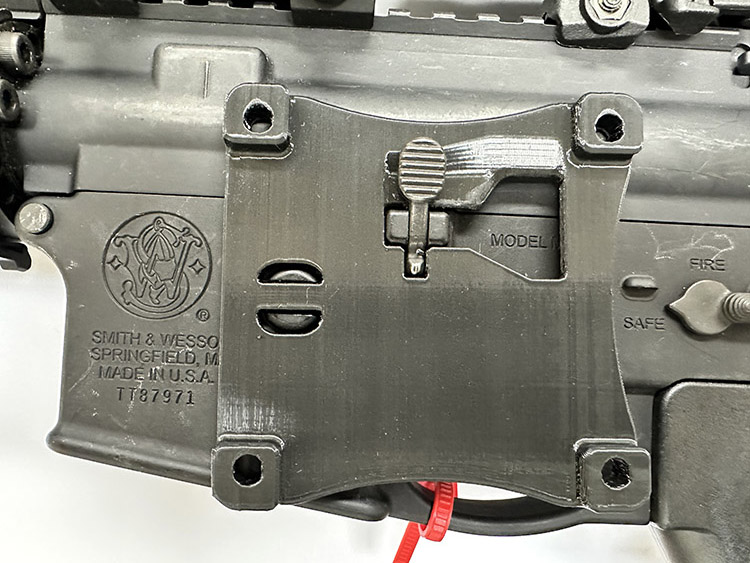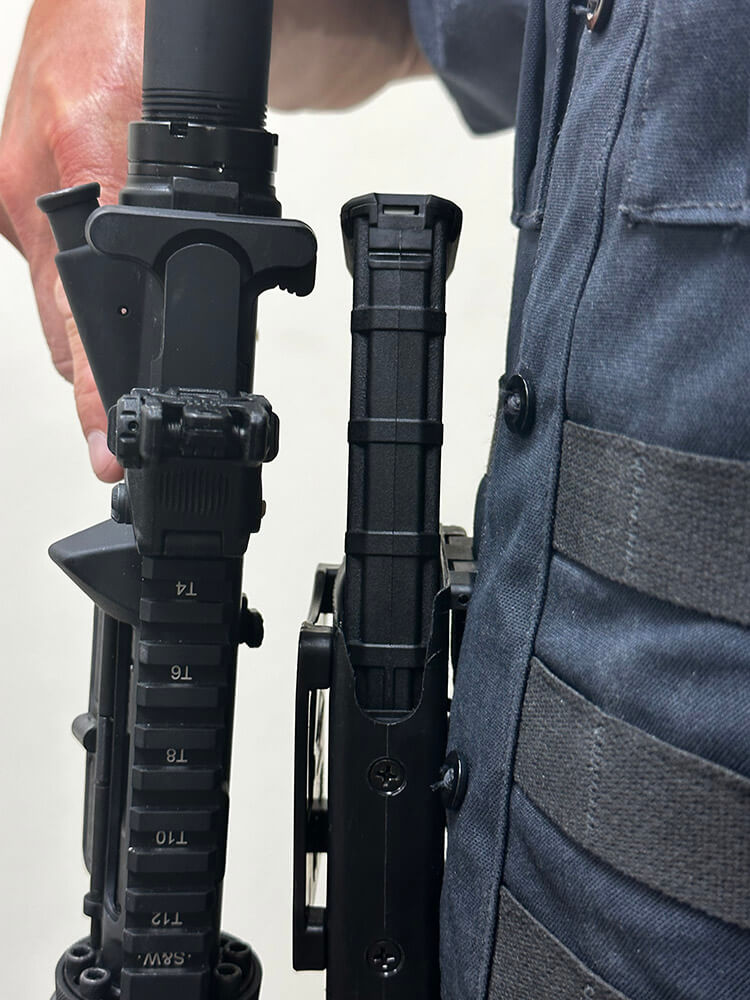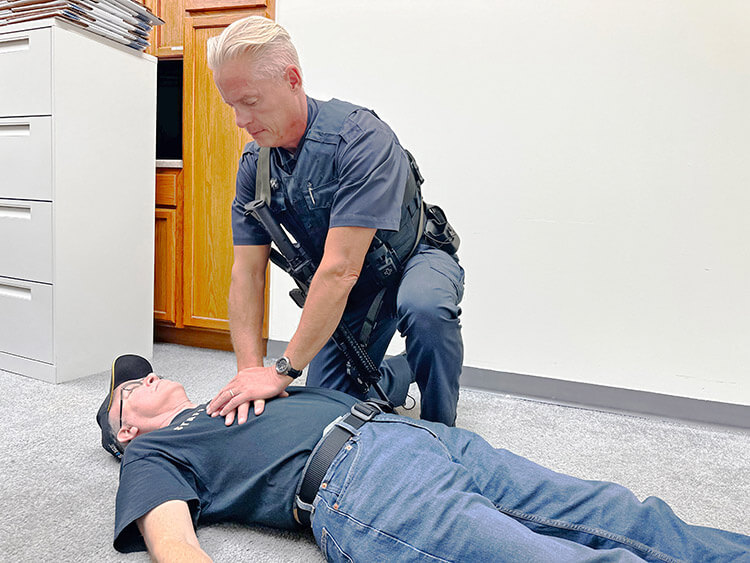PATROL RIFLE® HOLSTER
Patent Pending
For pricing and accessories, click this link.
The patent pending Patrol Rifle® Holster (PRH) is designed for use by LEO’s in passive environments. The concept is to give LEO’s a means to holster the rifle, so their hands are free for other tasks while they maintain positive control of the rifle, just like they do with a holstered pistol. The PRH gives officers an option to holster their rifle (when appropriate) at the conclusion of violent incidents, while working static posts, while working crowed special events, and even in the training environment. The PRH makes carrying a rifle much more comfortable while putting citizens at ease and will improve officer and citizen safety. Other applications may include recreational shooters, rifle- armed security officers and military personnel.
Benefits & Features of the Patrol Rifle® Holster
1. User comfort and positive rifle control:
- Reduces a slung rifle's weight from the user’s neck & shoulders.
- Maintains positive control of the rifle without using the hands (same as a holstered pistol). Keeps the rifle directly in front of the user’s body (gig line) and within their view creating constant patrol rifle awareness.
- Disables the holstered rifle's magazine release function. No more lost or embarrassing dropped magazines at the conclusion of violent scenes, while working a post, or in front of crowds.
|
5. Stability: When the Patrol Rifle® Holster is used PROPERLY, a holstered rifle will barely move as the user moves, turns, bends, and kneels.
- The Patrol Rifle® Holster MUST be attached directly to MOLLE-compatible external body armor and used in conjunction with a PROPERLY adjusted, quality, adjustable 2-point sling. This will keep the rifle from swinging in and out as the user moves and prevent the rifle from hitting the user’s lower body.
- The Patrol Rifle® Holster also incorporates a raised ridge that inserts into the magazine release slot on the left side of your MILSPEC rifle that keeps the rifle from twisting to the left or right.
|
2. Public perception: Improves the public’s comfort level when seeing rifle-armed LEOs while giving LEOs the offensive power and accuracy they may need at a moment’s notice to protect the public.
- LEO’s don’t look threatening when their hands aren’t on the rifle (same as a holstered pistol) enabling agencies to more frequently deploy rifle-armed officers to special events like parades, festivals, concerts, and other events where large crowds gather.
|
6. Ambidextrous:
- Lefties using the Patrol Rifle® Holster will draw and holster their patrol rifle with a right-handed grip and transition to a left-handed shooting position.
|
3. Safety: Increases officer and citizen safety. Slung rifles present two consistent safety concerns. The first is that the rifle's safety can get accidentally moved to the fire position as the rifle bounces around. Second, muzzles can easily be pointed in unsafe directions as the user is handling the rifle and as they move, turn, bend, and kneel.
- A MILSPEC rifle that is holstered in the Patrol Rifle® Holster has its safety switch blocked when a 30-round magazine is stowed in the Patrol Rifle® Integrated Magazine Pouch, making it improbable for the rifle’s safety to be accidentally moved from safe to fire, even as the user moves, turns, bends, and kneels.
- The Patrol Rifle® Holster keeps the muzzle of the rifle pointed at the ground even as the user moves, turns, bends, and kneels. In addition, the Patrol Rifle® Holster keeps the rifle's buttstock in the user’s lower peripheral vision keeping them constantly aware of the rifle’s orientation.
|
7. Training environment safety and efficiency: Increase range safety and save time so you can do more training.
- When the rifle is inserted into the Patrol Rifle® Holster and the bolt is locked to the rear (open), the bolt cannot be sent forward into battery, either on purpose or by accident. This makes it very easy for instructors to visually check and clear a line of shooters.
- The muzzle control provided by the Patrol Rifle® Holster helps to make the training environment exponentially safer.
|
4. Easy and simple to draw and holster the rifle: Simplicity at its finest using nothing more than your MILSPEC rifle's standard parts for new functionality. America baby!
- Users can expect a draw and presentation speed that is about as fast as that of a slung patrol rifle.
- Comes standard with a MOLLE Patrol Rifle® Integrated Magazine Pouch.
|
8. Parts: The Patrol Rifle® Holster is ready to use with no modification or changes to your MILSPEC patrol rifle.
- No additional parts need to be added to your rifle.
|

Modified Belt Plate with Patrol Rifle® Holster (front view)

Milspec rifle holstered in the Patrol Rifle® Holster (rear view)

MOLLE Patrol Rifle® Integrated Magazine Pouch with Patrol Rifle® Holster
HOW IT WORKS: The PRH, unlike many other products on the market, does not require anything to be added or attached to your patrol rifle. The PRH allows the user of MILSPEC AR-15, M-4, or M-16 patrol rifles to hang the rifle by the bolt catch roll pin housing located on the left side of the lower receiver. Simply slide the top of your rifle’s bolt catch lever into the PRH and then push it downward until it locks into place. Most of the rifle’s weight is then rested upon the bolt catch roll pin housing. In addition, the magazine release housing guide snaps into the PRH, which helps prevent the rifle from twisting, keeping the muzzle pointed at the ground while increasing everyone’s safety. Once the magazine release housing snaps into the PRH, counter pressure is exerted and the magazine release button becomes very difficult to actuate while in a standing position, which helps prevent your officers from accidentally dropping a magazine at the conclusion of violent incidents, while working static posts for long periods of time, or while working crowed special events.
To draw the rifle, twist outward on the rifle’s pistol grip while pulling it up sharply and out of the PRH. When violence surprises officers working in the passive environment (parades, festivals, special events) even first time PRH users can expect a draw and presentation speed that is about as fast as an average user of a slung patrol rifle (both hands either on, or off the rifle). If a faster draw stroke is needed due to the proximity of the violence, officers always have the option of drawing their handgun.
- IMPORTANT details, warnings and limitations:
- PRH can mar the finish of your rifle.
- PRH MUST be used in conjunction with an adjustable two point sling.
- PRH MUST be attached directly to your molle compatible body armor. Do not piggy back PRH onto other accessories that are attached to the body armor.
- PRH will not work with manufactured, or aftermarket left-handed magazine release products or left handed bolt catch levers.
- PRH will not work with BILLET manufacturers lower receivers and may not work with some billet manufactured upper receivers.
- PRH will not work in conjunction with chamber blocking devices.
SLINGS: The PRH is designed to be used with a quality two-point sling. It is not intended for use without a sling or a one-point sling. CMI can help you with recommendations and procurement of quality slings that work well with the PRH.
BODY ARMOR CARRIER SETUP: User comfort will dictate where the PRH is placed on your MOLLE compatible externally worn body armor or plate carrier. That said, we have found that a front mount just off the gig line (right side for righties…. left side for lefties) keeps the rifle sling in a comfortable position (not across your neck) and works best for the quickest draw stroke and for the holstering of the rifle. CMI can help you with recommendations and procurement of quality body armor and carriers that work well with the PRH.
- NOTE: The PRH MUST be used in conjunction with body armor (vest or carrier). The rigidity provided by body armor helps keep the PRH from moving. Body armor used in conjunction with a properly adjusted two-point sling are key components in the proper use of PRH.
AMBIDEXTROUS: PRH is ambidextrous even though MILSPEC rifles have the bolt-catch on the left side of the rifle. Lefties using the PRH will draw and holster their patrol rifle with a right-handed grip and transition to a left-handed shooting position.
- It is very important to set your rifle’s sling up for left-handed use and that the PRH is mounted just left of the gig line.
- In addition, we have found that by staging the sling on the outboard side of the rifle’s inserted magazine really helps the left-handed shooter to not get entangled by their sling. See the video below on frequently asked questions as these points are covered.
- NOTE: PRH will NOT WORK with manufactured, or aftermarket left-handed magazine release products or left-handed bolt catch levers.
PRH TRAINING: The PRH has created a whole new category of holster ware. Any training, drills, and policy regarding the deployment of the PRH are dictated by your agency. Even though the PRH is a very simple product to use, we recommend your agency provide some level of training on its proper and safe use prior to the deployment of this product.
TRAINING ENVIRONMENT SAFETY AID: Your agency’s firearms instructors will appreciate the added safety element that the PRH can bring to your range. Your agency’s training policies and or rules will dictate how you might use the PRH during patrol rifle training.
- COLD RANGE EXAMPLE: At the conclusion of a course of fire all patrol rifles are supposed to be made safe (safety, mag., bolt). Patrol rifles at lock back can very easily have the bolt sent home with the slightest bump of the rifle, which can be a safety hazard if a round was left in the chamber, a loaded magazine was left in the rifle, or the rifle’s selector lever was left in the firing position.
- Using PRH, a locked open bolt cannot be sent home. The PRH keeps the bolt catch lever engaged upon the bolt carrier which prevents the bolt from inadvertently closing even when it’s bumped. This feature not only increases safety during cold range operations, but it makes it easy for instructors to look up and down the line and see that magazines are removed, bolts are locked open, chambers are free of a casing/round and muzzles are pointed in a safe direction (down). This efficiency can result in saving time, allowing for more training to be conducted safely.
- HOT RANGE EXAMPLE: At the conclusion of a course of fire the officers place their rifles on safe, the muzzles are depressed, and the students walk off the line with loaded rifles just like they do when patrol rifles are deployed on the street. During a
long day of training, attention to muzzle discipline can dwindle and the lasering of others with a hot rifle has been known to happen (both in training and on the street), especially when someone with a rifle around their neck begins moving around or bends over.
- Using PRH, students won’t get as tired or sore from carrying a rifle all day. When the rifle is holstered in the PRH, the possibility of the rifle twisting is reduced, keeping the muzzle pointed at the ground directly in front of the student. This function also keeps the butt of the rifle directly in front of the student’s upper chest (line of sight) which also helps keep students aware of the direction that their muzzle is pointing, even when they are moving, kneeling, or bending over.
- USE OF THE RIFLES SAFETY: Patrol rifles should always have their safety engaged unless the use of deadly force is imminent. Therefore, PRH users should have their patrol rifle’s safety engaged whenever they are using the PRH. This includes the following:
- before the rifle is being holstered into the PRH,
- while the rifle is being holstered into the PRH,
- while the rifle is fully seated in the PRH,
- and, during the rifles draw stroke from the PRH and until the rifle is on target.
- RIFLE RETENTION: Consider the use of joint lock control techniques for use with the PRH in conjunction with the rifle retention training that your agency is already providing. See the video
below on frequently asked questions as we discuss and demonstrate some joint lock control techniques for your consideration.
PRH MAINTENANCE & LIFE SPAN: PRH is an injection molded product that is made of a durable glass filled polymer. Maintenance requires nothing but wiping it down with a dry cloth. No chemicals of any kind should ever be used to clean the PRH. Daily inspection should occur to ensure all screws are tight and that the unit is in good working order. PRH is a disposable product with a life span that will vary depending on the frequency of use. For example, the PRH should last the average LEO, who only deploys the patrol rifle a couple times a shift, years before replacement becomes necessary. If your PRH wears out, you can inexpensively replace just that part of the MOLLE Patrol Rifle® Integrated Magazine Pouch.



















